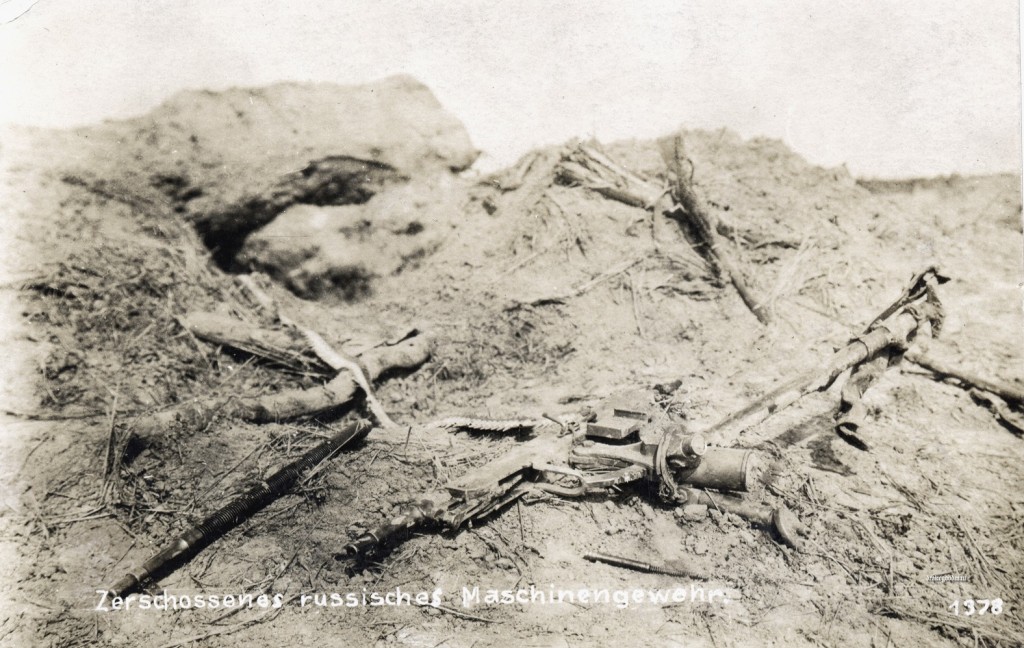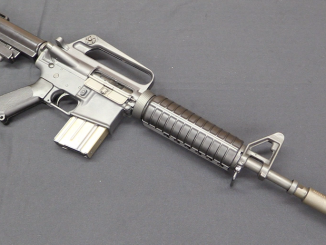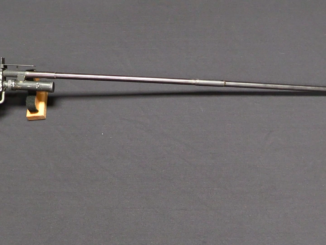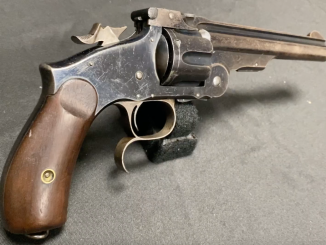
Russian Colt 1895 machine gun destroyed on the Eastern front, WWI.

Russian Colt 1895 machine gun destroyed on the Eastern front, WWI.

This two-stamp transferrable Colt 639 is being sold at Morphys on October 30, 2018. The Colt Model 639 was the export version of the Colt Model 629, which was type classified by the US military […]

The OSS experimented with a lot of…unorthodox weapons during World War Two, and one of their overarching goals was a weapon with a 100 yard lethal range but without flash or noise. To this end […]

This is lot #3124 in the upcoming RIA Premier Auction. It was scheduled for April, but has been postponed – check their web site for upcoming Online Only auctions every month, though! The Russian government […]
© 2025 Forgotten Weapons.
Site developed by Cardinal Acres Web Development.

Looks to me like it was made unusable to the enemy by retreating Russians.
The German text actually says:
“shot to pieces Russian machine gun”
Poor thing.
If it was on paper in the US, it would still be worth a lot money, despite it’s condition.
University ROTC “leftovers?
Pre 1934, there were just not that many restrictions in such goodies.
Didn’t the russians use gatling guns in the eastern front (among every type of artillery they have in their fortress) or i’m totally wrong ? I’m not even sure if they use that thing in the 1905 russo-japanese war.
Just thought of this and had to post it. Looks like the Mob was sending a message. You know. Broken leg?
What a pity from a historical standpoint. Of greater consideration is this — if this M1895 MG position was destroyed by enemy action, what about the poor fellows who were manning it?
Arkansas State University Museum, for some odd reason, has several weld-demill Colt and Marlin Potato diggers. I’ve often wondered how they came into possession of so many of the (basically) same model rare, obscure MG, when the balance of their MG collection only consists of a couple Thompsons.
Looks like they weren’t able to give em the whole nine yards!
Little historical recognition: where and when approximately was this photo taken?:
Not looking at the address (URL) of the photo makes it a bit more challenging.
I notice there aren’t any body parts, or uniform bits visible but I do see one M91 Mosin-Nagant rifle in the upper right and what looks like the front half of another on the far right. Just off hand this looks to me like a “toss the enemy stuff over there for the assistant S-2 to look at, if the REMF ever shows up” pile. Such piles are created by the winning side after a firefight for nominal intelligence value and to ensure your platoon gets full credit for weapons captured. Of course some small items of no possible intelligence value (Pistols, Knives, Cash money, Alcoholic beverages and such like.) have been retained by the platoon to be used in the Advancement of The Great Cause.
I visited the Military Vehicle Technology Museum last weekend (the late Jacques Littlefield’s tank collection); they have just finished cutting up dozens — maybe a hundred — machine guns that were mounted on vehicles, and welding up the breech blocks on some of the tanks. The tour guide told us (though he may have been biased) that the ATFE and the Foundation had dickered back and forth for several months, but in the end the AFTE won. I suspect many of the guns were found to be deact/demill to wierd, old, or foreign standards — simple plug in the bore, or something. In any case, a sad sight: a huge pile of torch-cut guns, mostly M2HBs, on the shop floor.
I remember reading that Littlefield himself had a high-level FFL permit, for cannons, machine guns, destructive devises etc.; my suspicion is that his family and/or the Foundation didn’t realize what they would need to do to keep the collection’s guns un-molested/legal. After he died, most of the staff were laid off, and only a few rehired recently to get the collection in shape for the upcoming auction and transfer.
So if you can make it to the museum (only open for a few more weeks), yes, a very sad sight for collectors.
Moral of the story: firearms can make a complicated estate
I heard from a connected source that ATF actually flagged two RESIN dummy guns as machine guns in that collection. Oy.